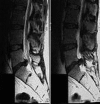Outcome of nucleoplasty in patients with radicular pain due to lumbar intervertebral disc herniation
- PMID: 23633860
- PMCID: PMC3633275
- DOI: 10.4103/0976-9668.107288
Outcome of nucleoplasty in patients with radicular pain due to lumbar intervertebral disc herniation
Abstract
Background: Nucleoplasty (percutaneous lumbar disc decompression) is a minimally invasive procedure that utilizes radiofrequency energy as a treatment for symptomatic lumbar disc herniation, against open microdiscectomy, which would be the mainstay treatment modality. The literature reports a favorable outcome in up to 77% of patients at 6 months.
Aim: To evaluate the effectiveness of nucleoplasty in the management of discogenic radicular pain.
Materials and methods: The medical notes of 33 patients, admitted for nucleoplasty between June 2006 and September 2007, were reviewed retrospectively. All had radicular pain, and contained herniated disc as seen on magnetic resonance imaging (MRI) of lumbosacral spine. Patients were followed up at 1 and 3 months post-procedure. The outcome measures employed in this study were satisfaction with symptoms and self-reported improvement.
Results: Thirty-three cases were examined (18 males and 15 females). Twenty-seven procedures were performed with no complications and six were abandoned due to anatomical reasons. There were 18 and 15 cases of disc herniation at L5/S1 and L4/5 levels, respectively. Four weeks following the procedure, 13 patients reported improvement in symptoms, and 14 remained symptomatically the same and subsequently had open microdiscectomy.
Conclusion: Nucleoplasty has been shown to be a safe and minimal-access procedure. Less than half of our selected cohort of patients reported symptomatic improvement at 1-month follow-up. We no longer offer this procedure to our patients. Possible reasons are discussed.
Keywords: Lumbar disc herniation; nucleoplasty; radicular pain.
Conflict of interest statement
Figures
Similar articles
-
Quality of life assessment in patients undergoing nucleoplasty-based percutaneous discectomy.J Neurosurg Spine. 2006 Jan;4(1):36-42. doi: 10.3171/spi.2006.4.1.36. J Neurosurg Spine. 2006. PMID: 16506464 Clinical Trial.
-
The results of nucleoplasty in patients with lumbar herniated disc: a prospective clinical study of 52 consecutive patients.Spine J. 2007 Jan-Feb;7(1):88-92; discussion 92-3. doi: 10.1016/j.spinee.2006.02.033. Epub 2006 Nov 20. Spine J. 2007. PMID: 17197339 Clinical Trial.
-
CT-guided nucleoplasty with radiofrequency energy for the treatment of lumbar disk herniation.J Spinal Disord Tech. 2015 Feb;28(1):E9-16. doi: 10.1097/BSD.0000000000000132. J Spinal Disord Tech. 2015. PMID: 25023711 Clinical Trial.
-
[Lumbar nucleoplasty].Harefuah. 2014 Jul;153(7):407-10, 432. Harefuah. 2014. PMID: 25189032 Review. Hebrew.
-
Alternative strategies for lumbar discectomy: intradiscal electrothermy and nucleoplasty.Neurosurg Focus. 2002 Aug 15;13(2):E7. doi: 10.3171/foc.2002.13.2.8. Neurosurg Focus. 2002. PMID: 15916404 Review.
Cited by
-
Comprehensive comparison of therapeutic efficacy of radiofrequency target disc decompression and nucleoplasty for lumbar disc herniation: a five year follow-up.Int Orthop. 2018 Apr;42(4):843-849. doi: 10.1007/s00264-017-3661-5. Epub 2017 Oct 31. Int Orthop. 2018. PMID: 29090325
-
Efficacy of Single Level Versus Double Levels Surgery of Percutaneous Disc Nucleoplasty (PDN) Approach in Treating Lumbar Disc Herniation.Med Sci Monit. 2021 Jul 29;27:e930000. doi: 10.12659/MSM.930000. Med Sci Monit. 2021. PMID: 34321453 Free PMC article.
-
Discogenic Back Pain: Literature Review of Definition, Diagnosis, and Treatment.JBMR Plus. 2019 Mar 4;3(5):e10180. doi: 10.1002/jbm4.10180. eCollection 2019 May. JBMR Plus. 2019. PMID: 31131347 Free PMC article.
References
-
- Long MD. Decision making in Lumbar disc disease. Clin Neurosurg. 1991;39:36–51. - PubMed
-
- Alo KM, Wright RE, Sutcliffe J, Brandt SA. Percutaneous Lumbar discectomy: Clinical response in an initial cohort of fifty consecutive patients with chronic radicular pain. Pain Pract. 2004;4:19–29. - PubMed
-
- Carey TS, Garrett J, Jackman A, McLaughlin C, Fryer J, Smucker DR. The outcomes and cost of care for acute low back pain among patients seen by primary care practitioners, chiropractors, orthopaedic surgeons. The North Carolina Back pain Project. N Engl J Med. 1995;333:913–7. - PubMed
-
- Lipetz JS. Pathophysiology of inflammatory, degenerative, and compressive radiculopathies. Phys Med Rehabil Clin N Am. 2002;13:439–49. - PubMed
-
- Yorimitsu E, Chiba K, Toyama Y, Hirabayashi K. “Long-term outcomes of standard discectomy for lumbar disc herniation: A follow-up study of more than 10 years.”. Spine (Phila Pa 1976) 2001;26:652–7. - PubMed
LinkOut - more resources
Full Text Sources
Other Literature Sources

